Is Ecuador Safe for Tourists in 2025?
Disclaimer: Some links on this page may be affiliate links. If you purchase anything through them, I will receive a small commission at no extra cost to you! Further details in the Privacy Policy.
Ecuador is not a very safe country for tourists in 2025, with the exception of the Galapagos Islands which are very safe to visit, although the situation has at least stabilised since conflict broke out in January 2024 between cartels and the government.
Whilst tourists are not the target, there is still a risk of getting caught in the crossfire.
Ecuador has been growing a reputation in recent years for becoming a key nation for drug smuggling, just like neighbouring Colombia.
Ecuador also has a lot of street crime and muggings, which I was almost a victim of in Quito back in 2022 when things were a little calmer than they are now.
You can visit the Ecuadorian mainland safely, but extra precautions are necessary. Read on to find out the dangers of this otherwise beautiful country, and how you can avoid them.
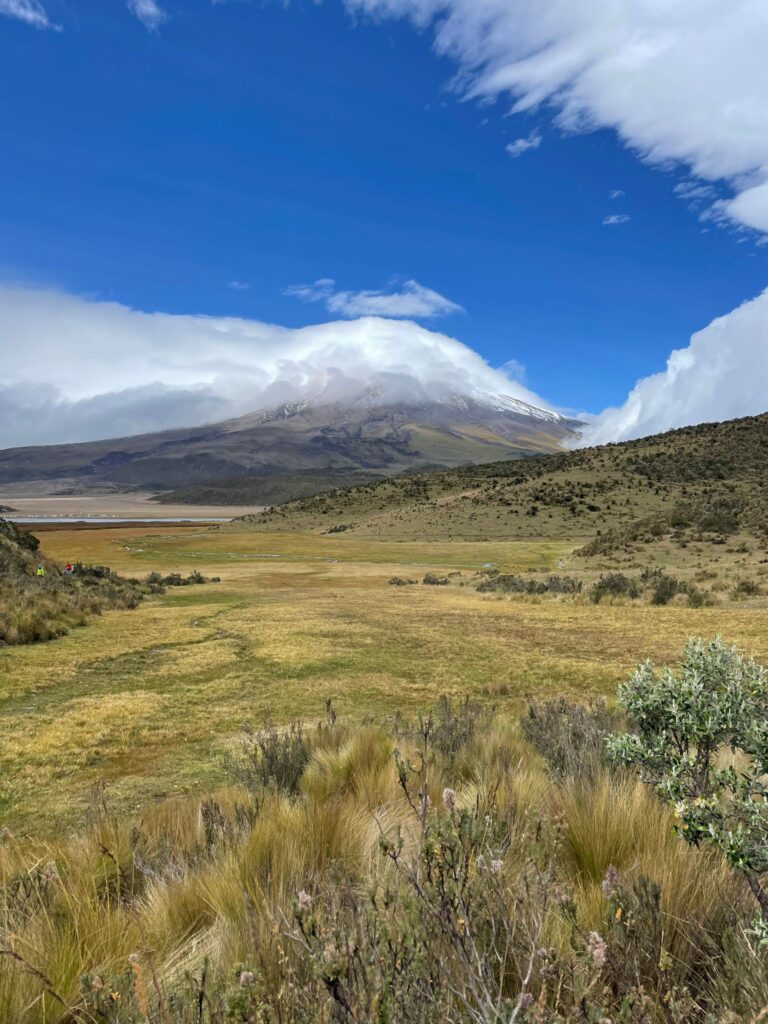
First-Hand Experience of Safety in Ecuador as a Tourist
During my first Latin America trip in 2022, I spent 8 months in the region visiting most countries. I only missed Venezuela (perceived to be too dangerous at the time) and the Caribbean nations (expensive and logistically inconvenient).
I since returned to Latin America in 2024 and 2025, and have now explored every Central and South American country.
I heard that the likes of El Salvador, Honduras and Colombia could be dangerous, and took extra care in these countries. I had no issues in any of them. In fact, El Salvador is now one of the safest countries in the Western Hemisphere.
Brazil, Guyana and Suriname felt unsafe, but at least in these cases I had an idea they would be before I arrived.
Ecuador on the other hand was the one country I’d heard few bad things about, but it turned out to be a lot more dangerous than I expected.
As a result it is ranked low compared to the other South American countries I’ve been to (all of them), which is a shame as it has a lot to offer.
The First Warning Signs
I flew into the capital city Quito, from Bogota in neighbouring Colombia, and took a taxi to my accommodation, the excellent Community Hostel.
The first warning sign I got came as soon as I arrived. Staff showed me round, and took me to a balcony overlooking the streets below.
I was told it is dangerous to go out at this time of day, despite the sun only just starting to set.
“Even there?” I asked, pointing to a building around a 20-second walk from the entrance.
“Yes” replied the receptionist. She went on to explain that you should never get your phone out in the street. If only I’d listened…
Day One in Quito – A Tense Atmosphere
I went out early on my first morning to walk around the streets before joining up with a free walking tour of the capital.
There was a very eerie vibe. Few people were out on the streets, and one thing in particular caught my attention.
Almost every shop in the immediate surrounding area was like a prison cell. You couldn’t go inside, you would have to peer through metal bars and ask the shopkeeper on the other side if you wanted anything.
I’ve seen this on occasion in Latin America, but not to the extent I did in Quito.
And meeting up with my walking tour guide wasn’t any more reassuring. One of the first things he did was give us a talk about pickpocketing and say there have even been incidents which have taken place on the tour itself.
Narrowly Escaping a Mugging Attempt
Despite the tense vibe, I enjoyed what I had seen in Quito, and the highlight came with a trip to the Mitad del Mundo monument which marks the point at which the equator crosses through the city.
If it wasn’t obvious, Ecuador is the Spanish word for equator, and this is what the country was named after.
Anyway, on the way back my bus didn’t stop where it should, and left me stranded a further 10-15 minute walk away, next to a shady marketplace.
Long story short, I was completely lost, had to take my phone out to check maps, and ended up having it snatched out of my hand by three would-be muggers.
I grabbed it back, fought my way out of the circle and ran, but at this point, I’d had a taste of Ecuador’s dark side.
You can read my mugging story in full, if you wish.
I had my guard up for the rest of my time there, and never got my phone out in the streets again. This was the day I learnt to head into the nearest cafe, shop or restaurant if I needed to check anything.
Three years on and I strictly abide by those rules. I haven’t had a similar incident since.
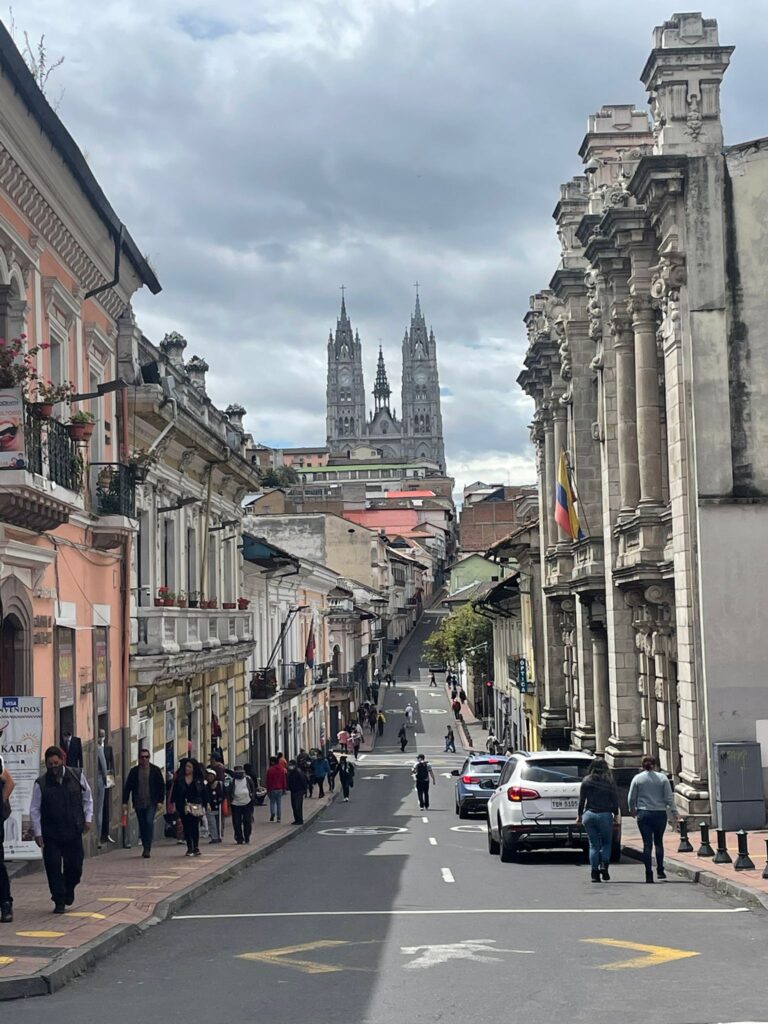
What are the Main Dangers in Ecuador in 2025?
Now I’m the first person to tell you that travel horror stories are often overstated, and countries are much safer than people will often tell you. Especially those who haven’t been…
Former murder capital El Salvador has transformed into one of Latin America’s safest countries. Whilst even conflict-torn Myanmar is safe for tourists. I can tell you this because I’ve been to both places, I’ve spoken to locals and I’ve travelled in them first hand.
However I will say that Ecuador is a little more dodgy. Some crimes are more likely than others to impact on tourists, but we’ll have a look at the main ones here.
Violent Crime
Ecuador was once known for its relative peace, with violent crime associated more with neighbouring Peru, and most notably Colombia.
However, that has changed now.
Ecuador hit global headlines in January 2024 when an armed gang stormed a live TV set and took staff hostage. In the coming days, there were armed attacks on hospitals, shopping malls and in prisons, whilst explosives were also found.
The gangs declared war, and the government announced a state of emergency, which lasted until April 2024 across the country, but is still in place in more dangerous provinces even now in 2025.
Here’s a list of provinces where the state of emergency still applies.
Whilst gangs do not target tourists, they are attacking areas frequented by foreign visitors, meaning it is possible to get caught in the crossfire.
On a lower level, muggings are not uncommon, and anyone who flashes the slightest glimpse of wealth is a target.
Whilst I was lucky and didn’t see any during my own experience, muggers do often carry weapons (more specifically, knives and guns). So be wary of this and remember that “prevention is better than the cure”.
Theft
There is a strong crossover between violent crime and theft, because a lot of robberies in Ecuador take place with the use of force.
On the softer end of the scale, you could be subtly pickpocketed. The risk of this is high on public transport. Do not get your phone out at any point on buses or trains, and have tiny amounts of cash loose in your pocket to pay the driver.
Pickpocketing is also rife around tourist spots, particularly in Quito which is one of the most common destinations for foreign travellers.
On the more violent end, you could be mugged with the use of force or weapons. You are more likely to experience this when walking around at nighttime and/or when travelling alone.
I would advise using taxis to get around, and only walking when in tourist bubble locations where the risk of being singled out is lower if you take precautions to lock your bags and hide your valuables.
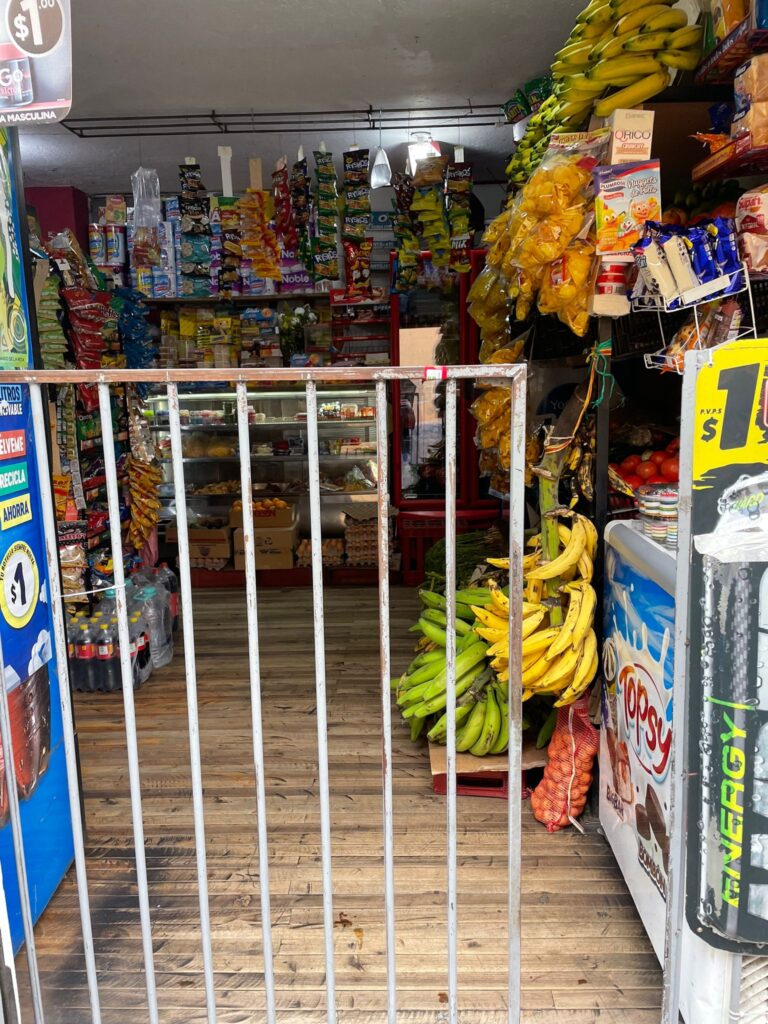
Drug Crime
Getting involved in drugs is stupid at the best of times, but even more so in a country like Ecuador.
In fact most of the violence in the country today stems from rival gangs fighting to take control of lucrative drug routes that ultimately lead to Europe and the US.
Be careful in particular whilst crossing the land border into Colombia, travelling through regions along the western coast, and in the notorious port city of Guayaquil. Guayaquil is pretty much the epicenter of Ecuador’s problems today.
In fact I met an Ecuador fan at the 2022 World Cup in Qatar who told me I was crazy for visiting Guayaquil, his home city, due to all the violence there. And that was before the current situation escalated heavily.
If offered drugs, say no and walk away calmly. People who sell them are linked to the gangs, and by becoming a customer, you are funding the conflict taking place today.
Not only that, but you make yourself a target for gangs. The average tourist will not be intentionally targeted, but anyone involved in drugs might be sucked in. Stay away.
Demonstrations
One unfortunate downside of my beloved Latin America is that disruptive demonstrations occur frequently, and Ecuador is no exception.
I almost didn’t come here during my first Latam trip in 2022 because the whole country was shut down for several weeks by protests, with roads blocked and many major transport arteries completely shut down. Food shortages occurred as a result with deliveries unable to take place.
In the end there were hundreds of arrests and injuries, plus a handful of deaths as both protestors and police used violent force.
Ironically, a week wiped out with the flu in Colombia turned into a positive for me, as the protests cleared up by the time I recovered.
In total they were ongoing for 2.5 weeks.
Demonstrations are rarely as major as this one, but caution is advised. Get too close to one, and there is no guarantee that force won’t be used.
It is also illegal to join one as a foreigner.
Indirectly, roadblocks and (in rarer cases) food shortages can have an impact on tourists, so keep an eye on local news before planning a trip here.
Although be advised, protests do often take place at very short notice and may catch you by surprise.
Nature and the Environment
When we talk about how safe a country is, we generally focus on crime, war and terrorism. Yet we don’t mention the climate, natural disasters and other dangers posed by natural threats, rather than manmade issues.
In some countries, particularly around the Pacific Ocean, the environment can be the biggest threat of all.
Whilst perhaps not the biggest threat in Ecuador, there are some things to be aware of.
Firstly, Ecuador is a mountainous country. Located in the Andes, it has the third-highest elevation of any country in the Americas (behind Chile and Bolivia).
This means that altitude sickness can pose problems, especially for people who fail to acclimatise.
In high-altitude environments, it is important to have a few quiet days to begin with, without much strenuous activity. Only after taking some time to settle in should you consider any big hikes.
Even then, there’s no guarantee you will be okay. I was hit hard by altitude sickness in the Bolivian altiplano late in 2024. Trust me when I say it isn’t pleasant.
Quito is also the world’s highest capital city, at 2,850m (9,350ft) above sea level. The Andes form a big line, straight down through the central third of the country as you see it on a map, so these are the places to be wary of altitude issues.
Secondly, there are many active volcanoes in Ecuador. Fortunately, there haven’t been any more than 5 deaths in an eruption since 1877, when Cotopaxi erupted. However, they can still erupt, which means you should keep a close eye on local media, and listen to advice from the local authorities who can let you know if an eruption is imminent.
Thirdly, being a part of the Pacific Ring of Fire means Ecuador is susceptible to earthquakes. Whilst infrequent, they can be deadly. There were 18 deaths in the 2023 Guayas earthquake, almost 700 in the infamous 2016 Ecuador earthquake, and over 5,000 during a series of tremors in 1987.
Now the fact I’m going back to 1987 for these scary stats does at least show that such major incidents are highly unlikely. But, there is always a risk in this part of the world.
Finally, there is always a risk of heavy flooding in Ecuador, so be wary of that too.
Dangers to Health
International travel often leads to great adventures. Unfortunately, some of the best places to visit can put your health at risk.
Travel health is an important subject. And visiting the Amazon in particular can cause issues if you aren’t prepared.
Whilst the risk of malaria is very low in Ecuador, there is a possibility that you may come into contact with dengue fever or zika virus.
All of these diseases are found in mosquitos, which are common in rural areas, coastal regions and the Amazon Rainforest. They are much rarer in the Andes, especially at high altitudes.
Rabies is also prevalent in Ecuador, so stay away from stray dogs and bats in particular. If bitten by any mammal, go straight to your nearest hospital and ask for rabies treatment. This disease is fatal when symptoms appear, so it is vital to get treatment as soon as you are bitten, even if you don’t know if an animal is infected with the disease.
Elsewhere, Hepatitis A and Tetanus vaccines are recommended for all travellers visiting Ecuador.
All of this information and everything else you need to know about travel health in Ecuador comes from the experts at Travel Health Pro.
You should always check a professional travel health site, such as Travel Health Pro, for health advice before your trip.

What do Travel Advisories say About Visiting Ecuador?
Regular readers of this blog may know that I’m not a big fan of government travel advisory websites. They tend to overstate the dangers of countries (understandably, given the PR consequences if something goes badly wrong).
I also find them to be slow to pick up information. The 2022 Ecuador protests were a perfect example of this. It took around two weeks for the UK government to advise against travel to Ecuador, and things had calmed down for a week by the time this information was removed.
That being said, they are still worth reading for a rough idea of what hazards you may potentially encounter.
Although I’d suggest supplementing government travel advice with tips from locals and recent travellers to your intended destination(s).
I would say this is the best way to find accurate safety advice, and my favourite resources are Facebook groups.
More specifically, Facebook groups dedicated to the country you’re visiting (in this case: Ecuador Travel Information) and the excellent Every Passport Stamp group.
The latter is a place where thousands of very experienced travellers share logistical information on more challenging countries.
People there will give you up-to-date information on the safety situation in Chad or Sudan (for example) from recent travels and on-the-ground knowledge. Ecuador by comparison is a pretty “easy” country to advise on by the standards of the group.
Anyway, here’s what travel advisories have to say about visiting Ecuador:
United Kingdom
The UK advises against non-essential travel to coastal regions stretching down to Peru and including Guayaquil, as well as along the Colombia border.
This is a fair assessment. I’ll be talking more about those spots later on. And they are where the majority of problems occur.
The UK talks of violent crime, in particular in Guayas and Esmeraldas provinces. They also talk about a higher risk of pickpocketing, particularly on transport, and a risk of demonstrations.
I said I’m not a big fan of government travel advice. But the UK gets it pretty spot on here.
They go on to state that there have been incidents of sexual assault, particularly in Santa Elena, a province on the coast which draws tourists to its beaches. Spiking drinks has been a major cause of this, so be careful and keep drinks covered if you visit.
The one area in which the UK does exaggerate the dangers is kidnapping. Yes, kidnapping does occur in Ecuador, but it almost always only affects locals.
They speak of “express kidnappings” where your attacker takes you to an ATM, and leaves you alone after taking your money. Again, whilst these occur, they are very rare incidents for tourists, and can easily be avoided with standard safety precautions.
USA
The USA talk about similar issues with violent crime, kidnappings and demonstrations.
They advise against travelling to several locations in the country, including Guayaquil. Whilst Guayaquil is pretty dangerous, it’s also a key transit point, with both international flights, and buses down to Peru.
When I was there, I only went to the heavily-guarded Santa Ana Hill. It’s not worth trying to see other attractions as it simply isn’t safe.
One thing the US adds is that you need an apostilled criminal record check to enter Ecuador via the Colombia or Peru land borders.
Australia
Australia advises against travel to the Colombia border, whilst also stating a lot of what I’ve already mentioned.
Violent crime is a risk here, theft is common, and demonstrations are frequent.
One important point that Australia adds is that it is illegal for foreigners to join in with protests, regardless of how safe they may or may not be.
They do also speak of the active volcanoes within Ecuador, and advise listening to local authorities for updates.
Canada
Aside from what has already been covered, Canada brings up issues of landmines around Chinchipe, El Pangui, Nangaritza and Yantzaza which are all around the Peru border.
I left Ecuador overland by taking a bus down from Guayaquil to Tumbes. It is safe to go near this part of the Peru border, especially whilst taking organised transport to or from the country.
But it’s best to stay away from the borders, unless using common crossing points.
Safest Places in Ecuador
The Galapagos Islands are very safe to visit. In fact they are by far the safest part of Ecuador to travel to at the moment. You can get there by flying out of either Quito, or Guayaquil, as there are no international flights.
Whilst both cities have their problems, it is safe to transit through the airport.
The Galapagos Islands are of course famous for being a nature paradise, and the place that inspired Charles Darwin’s evolution theory.
The safest place on the mainland is Cuenca. This city located 3.5 hours east of Guayaquil is a colonial city, best known for being a UNESCO World Heritage Site.
It also has a major gringo (foreigner) population and avoids a lot of the crime that plagues mainland Ecuador elsewhere.
The other major safe place for tourists in Ecuador is Baños. This small city in the country’s centre is the adventure sports capital of Ecuador.
You can go canoeing, bungee jumping, white water rafting and more. You can also hike in this scenic city, but after getting lost myself and running into a spot of bother, I’d suggest doing so with a guide.
Baños has a lot of similarities with San Gil in Colombia, another adventure sports hotspot.
Cuenca and Baños are the safest cities in Ecuador to visit right now. In fact Baños is one of the safest cities on the continent.
Most Dangerous Places in Ecuador
On the other side of the coin, some places in Ecuador are more dangerous than others.
Quito is dodgy, and I’ve heard the same from others who didn’t have the near miss I did. But we’ll cover the capital in more detail in the next section.
Alongside Quito, Guayaquil is the most important of Ecuador’s major cities. And let’s not beat around the bush here, Guayaquil is dangerous.
A violent crime hub even before the 2024 conflict, I played it very safe during my 2022 visit to the city. By that I mean only travelling by taxi (Uber) and only visiting one place – Santa Ana Hill.
This hill stood out as it had a heavy armed police presence, being one of the city’s few major tourist spots… for the few tourists that still remain.
Taking Uber from door-to-door, and being surrounded by heavily armed police minimised the risk, but at the end of my trip there, I had to hide in a supermarket for almost an hour whilst waiting for a taxi that wouldn’t cancel on me.
Anyway, that was when Guayaquil was less dangerous. Now it draws comparisons with war zones, is the epicentre of Ecuador’s illegal drug trade (it’s an important port city used for trafficking) and should only be used as a transit hub unless you really know what you’re doing.
In fact, according to the UNODC, Ecuador had the world’s 2nd-highest murder rate in 2023 behind only Jamaica, and even ahead of lawless Haiti. And Guayas, the province in which Guayaquil is based, was responsible for a remarkable 47% of them.
Unfortunately, there are no updated statistics for 2024 or 2025 yet.
Elsewhere, stay away from coastal regions. These are hotbeds of violent crime and drug trafficking. Esmeraldas in particular is infamous due to the amount of attacks taking place there.
Even Ecuadorians try to avoid these regions. And when a local says to stay away, you stay away.
Armed robbery isn’t uncommon in this part of the country, and it may be difficult to get hold of the emergency services, which are under a lot of pressure out here.
Lastly, avoid the Colombia border. As mentioned earlier, you now need an apostilled criminal record document to enter the country overland. And the reason is due to the sheer amount of drug smuggling that takes place here.
Now this border is perhaps the least-dangerous part of Ecuador mentioned in this section, mostly because the risks are much lower during the day.
But precaution is still advised. If you must cross overland, try to avoid public transport and travel in numbers, preferably with Spanish speakers in your group.
But flying to Ecuador is certainly the better option.
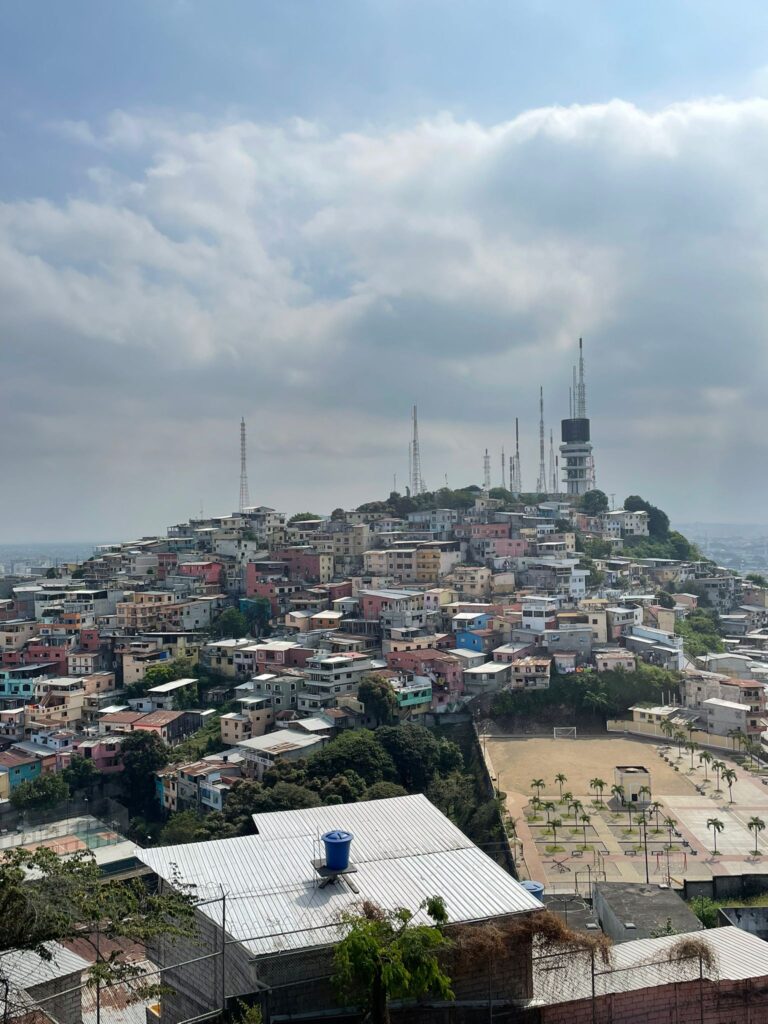
Is Quito Safe to Visit in 2025?
Quito is not the safest city to visit right now. Whilst it can be done safely, you do need to take a lot of extra precautions, and there is a lot of theft and violent crime here.
The streets are almost deserted after dark. As you can perhaps guess, there’s a good reason for this…
The equator monument (Mitad del Mundo) is part of a larger complex with a lot of activities and educational displays covering Ecuadorian history and culture. This is pretty much the safest place in Quito, and the only one where I never felt any risk of danger.
The Historic Center of Quito has a heavy armed police presence, but it also gets quite busy and is a pickpocketing hotspot. You will avoid the worst of Ecuador’s problems here, but should still take extra care.
Now the one part of Quito where you need to be VERY careful is the Virgin of el Panecillo. This giant religious statue on top of a hill looks pretty impressive, and is actually taller than Christ the Redeemer in Brazil, so you can certainly see the appeal.
However, to get to it, you need to travel through some dodgy slums, and I’ve heard numerous reports of muggings from people who have tried walking this short 500m route, even in broad daylight.
Criminals hide in the narrow alleyways and surrounding woods to catch visitors by surprise, knowing that the statue is a popular spot.
Even my walking tour guide who pointed out the statue from a distant viewpoint told us not to walk there at all costs.
Whilst buses do go to the statue, public transport in Quito is not particularly safe either. Your best bet is to take a taxi to and from the top of the hill. It should cost around US$8-10 at most for a return journey, including waiting.
Even away from the statue, I would avoid taking buses. Numerous robberies take place on them every single day. If you’re lucky, you will “only” have your bag slashed, or your phone swiped without you noticing straight away.
If you’re unlucky, you may fall victim to extreme violence.
Always use Uber in Quito.
Unfortunately, Quito is one reason why I ranked Ecuador as the most dangerous South American country.
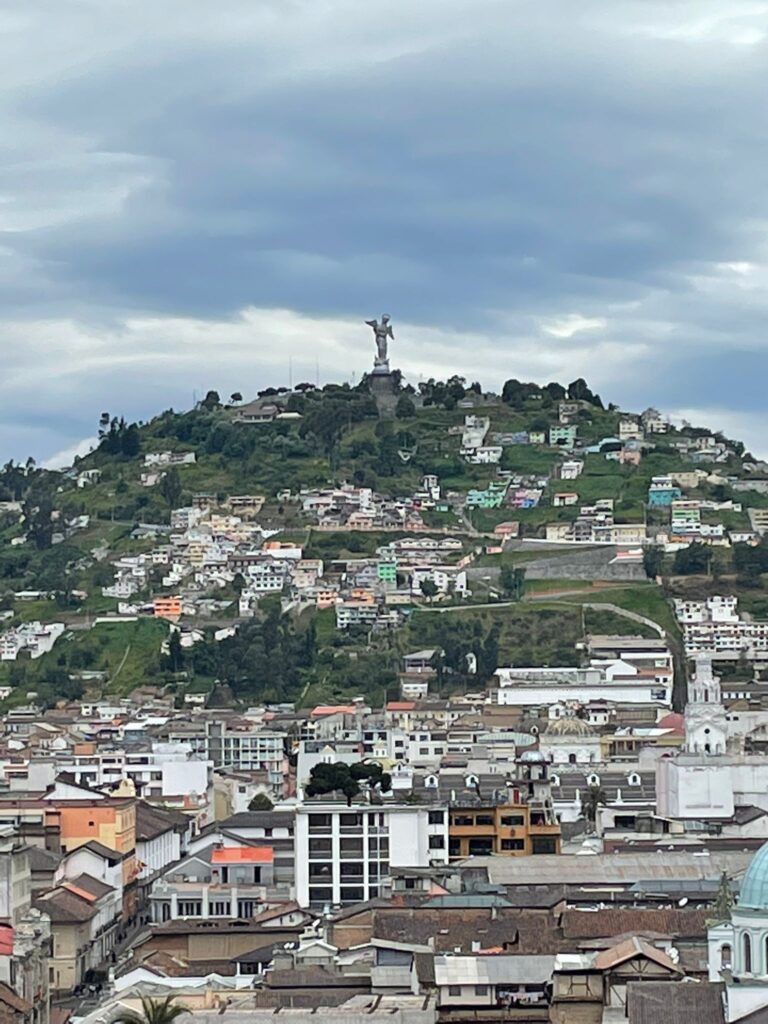
How to Stay Safe in Ecuador in 2025
You will need to take a lot of care whilst travelling around Ecuador, and should use tactics that come in handy in any dodgy part of Latin America.
Here are some of my most important tips for staying safe in Ecuador:
- Do not take your phone out in the streets: If you need to check directions or contact anyone, you should go inside the nearest shop, cafe or restaurant where you can hide out of sight and remain low key. This is the number one lesson I learn from almost being mugged in Quito, and I haven’t had any further issues since
- Take taxis from door-to-door in dangerous places: Do not risk walking or taking public transport in places like Quito or Guayaquil. Uber is very cheap and available in these cities. It’s okay to walk around within tourist bubble spots (Mitad del Mundo or Quito’s Historic Center for example), but Ecuadorian cities are currently not good places to go off the beaten path
- Dress down: The average Latino wears relatively plain clothing, with few people flashing brand names or wearing prominent jewellery. Having worn a watch daily for years, I no longer do so having got used to not wearing one whilst in Latam. The best way to stay safe is to blend in with locals
- Take extra care on public transport: I don’t recommend taking public transport in Ecuador, but if you do then make sure you have small dollar bills loose in your pockets to pay the fare. Do not get your wallet/purse or phone out at any time. Keep a close eye on your surroundings so you know which stop to get off at. And keep hold of your bags at all time
- Use locks on your bags: Use combination padlocks to lock compartments of your bags together. Especially when you carry valuables such as laptops or camera equipment. Also use a padlock with a cable so you can lock your bag to something and keep it safe when your back is turned. I use this to lock my bags to my legs whilst travelling on overnight buses. Not comfortable, but it keeps everything safe and secure
- Don’t use ATMs on the street: It goes without saying, this makes you a target. Go inside a bank or other secure building if you need to withdraw cash in public. Also be aware that card skimming devices are far more likely to be installed on outdoor machines with less security
- Copy important documents: Have copies of your passport and other important documents in multiple places. Worst case scenario and you get robbed, you can at least make things easier when contacting your embassy to sort everything out
- Spread risk: Have money in multiple places on your body and in your bags. It’s also wise to have at least two phones, which you keep in different places
- Have a dummy wallet and phone: Carry a wallet with a small amount of money and a couple of worthless cards (it needs to look genuine, just in case a thief does take it and check the contents at a glance). Also carry a dummy phone which you can hand over in the event of a robbery
- Purchase a local SIM card: It is vital to have internet in the case of emergencies, and for ordering taxis with the likes of Uber. A local SIM ensures you are connected at all times and can get help when you need it
Also take a look at my tips on safety as a solo traveller. Even if you aren’t travelling alone, there are a few things you can learn from there to make sure everything goes smoothly on your trip.
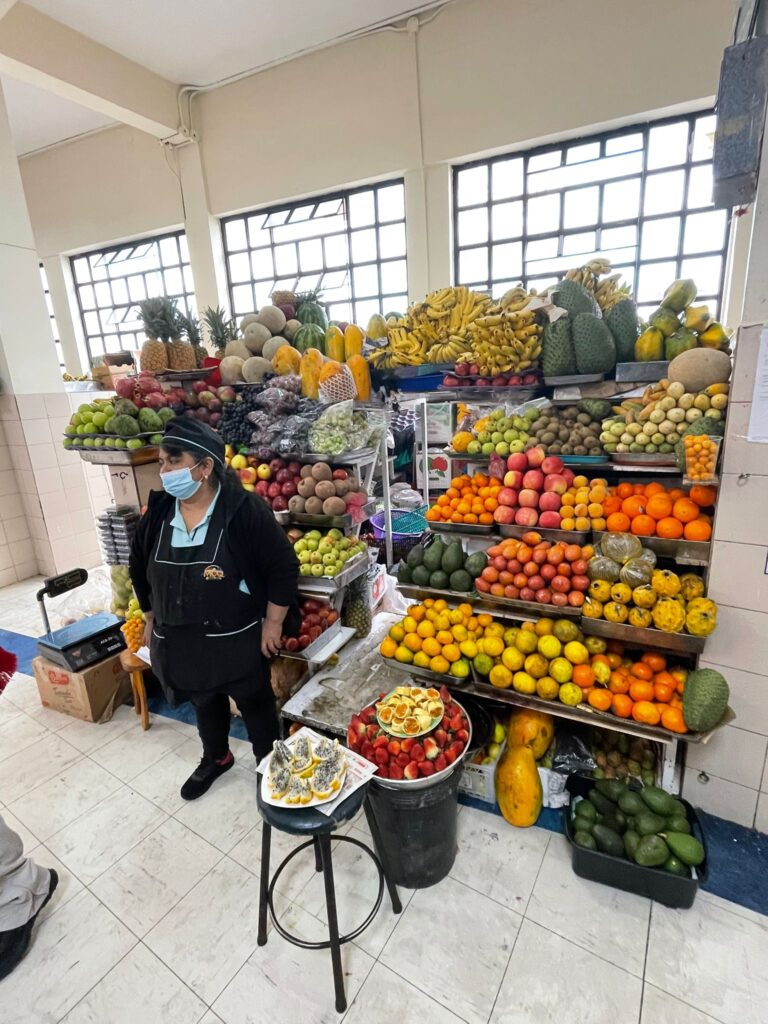
Is Ecuador Safe for Tourists to Visit in 2025?
You can visit Ecuador safely, if you take a lot of extra care to follow the advice mentioned in the previous section.
However, I would advise caution, and suggest only coming here if you have some experience travelling in grittier countries.
Ecuador is no longer the relative safe haven that it was, and I would not recommend it (excluding the very safe Galapagos Islands) for any first timers in Latin America. If you are unfamiliar with this part of the world, I would suggest sticking to the safest countries in the region to begin with.
Most of the worst violence in Ecuador affects locals only. Muggings are the most serious issue that target tourists on a semi-regular basis.
The good news is that things haven’t escalated since the conflict between government and cartels began a year ago in January 2024. Tourists are not specifically targeted, and most (but not all) clashes take place in dodgy neighbourhoods far from anything of interest to visitors.
You won’t end up in these spots by accident.
You will hear horror stories of kidnappings and brutal murders in Ecuador. Yes these happen, but your chances of being targeted as a tourist are minimal.
Therefore it’s important to strike a balance here. Is Ecuador currently safe? No. Is it effectively a warzone where you are guaranteed to be attacked the moment you step outside a building? No.
It’s something in the middle. It’s a country with a lot of problems, but many tourists, even the vast majority should be able to visit without incidents.
If we look at Ukraine, a warzone for 3 years, the population is around 38 million, and the number of casualties are thought to be under 1 million as of late 2024. Meaning, under 3% of the population have directly been harmed by the conflict.
In other words, 97% of people living in a warzone have been unaffected in terms of being direct victims of violence, having lived in an active conflict zone for three years.
Of course, a lot of nuance needs to be applied to those numbers. But the point is, that even in a dangerous region, the statistical risk of coming to harm is very low.
Much lower if we revert back to Ecuador and take into account the fact that you are a tourist in the country for a short period which significantly reduces the odds of you falling victim to crime, compared to a local living in the country for many years.
As a tourist, you are at higher risk of being targeted for theft, due to the perception of foreign tourists being rich.
However you are at a lower risk of being singled out for violence (unless you resist a robbery attempt), as drug gangs are more interested in harming each other and those who try to stop them (the police, military and government).
If you stick to travel around the Andean regions such as Cuenca, Baños and the famous Quilotoa Loop, then you can minimise risk and maximise your chances of visiting Ecuador safely.
Just treat this country with a lot of extra caution.
Look past the dark underbelly, and this is still a pretty awesome country with some incredible places to see.
Although if you do feel it’s a little too risky, consider a trip to neighbouring Peru instead.
If you need help planning a trip here safely, I will be more than happy to help you.
Other Travel Safety Guides
Safety By Country
- Is Bolivia Safe For Tourists To Visit?
- Is Argentina Safe For Tourists To Travel To?
- Is El Salvador Safe For Tourists?
- Is Ecuador Safe For Tourists In 2025?
- Is Myanmar Safe For Tourists In 2025?
- Is Paraguay Safe For Tourists To Visit?
- Is Venezuela Safe For Tourists To Visit In 2025?
Safety By Region
- The Safest Countries In South America In 2025: Ranked
- What Are The 10 Safest Cities In South America In 2025?
- Safest Latin American Countries To Visit In 2025
- Safest Southeast Asian Countries To Visit In 2025
- What Is The Safest City In Southeast Asia In 2025?
General Travel Safety Advice
More Posts on Ecuador
- The 17 Best Cities In South America To Visit In 2025
- The Safest Countries In South America In 2025: Ranked
- Best Countries In South America To Travel To: Ranked
- What Are The 10 Safest Cities In South America In 2025?
- The Ultimate 6 Month South America Itinerary On A Budget
- Is Ecuador Safe For Tourists In 2025?
- Surviving A Mugging Attempt In Quito

I visited Guayaquil in 2005. Was literally safe enough that you didn’t even consider crime, unlike Venezuela next door which was a nightmare. Spent a week, and the only thing worth mentioning was $10 hotels and the big lizards in the park in the center of the city. Sad to hear that it has got so bad.
It’s a real shame that Guayaquil, and Ecuador in general, have become fairly dodgy these days.
Interesting to hear that Venezuela had a lot of crime as far back as 2005. I hope to visit in the coming months to see what it’s like today.